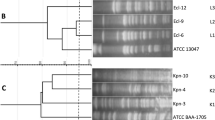Abstract
The Bacteroides genus, the most prevalent anaerobic bacteria of the intestinal tract, carries a plethora of the mobile elements, such as plasmids and conjugative and mobilizable transposons, which are probably responsible for the spreading of resistance genes. Production of β-lactamases is the most important resistance mechanism including cephalosporin resistance to β-lactam agents in species of the Bacteroides fragilis group. In our previous study, the cfxA gene was detected in B. distasonis species, which encodes a clinically significant broad-spectrum β-lactamase responsible for widespread resistance to cefoxitin and other β-lactams. Such gene has been associated with the mobilizable transposon Tn4555. Therefore, the aim of this study was to detect the association between the cfxA gene and the presence of transposon Tn4555 in 53 Bacteroides strains isolated in Rio de Janeiro, Brazil, by PCR assay. The cfxA gene was detected in 11 strains and the Tn4555 in 15. The transposon sequence revealed similarities of approximately 96% with the B. vulgatus sequence which has been deposited in GenBank. Hybridization assay was performed in attempt to detect the cfxA gene in the transposon. It was possible to associate the cfxA gene in 11 of 15 strains that harbored Tn4555. Among such strains, 9 presented the cfxA gene as well as Tn4555, but in 2 strains the cfxA gene was not detected by PCR assay. Our results confirm the involvement of Tn4555 in spreading the cfxA gene in Bacteroides species.




Similar content being viewed by others
Literature Cited
Aldridge KE, Ashcraft D, Cambre K, Pierson CL, Jenkins SG Rosenblatt JE (2001) Multicenter survey of the changing in vitro antimicrobial susceptibilities of clinical isolates of Bacteroides fragilis group, Prevotella, Fusobacterium, Porphyromonas and Peptostreptococcus species. Antimicrob Agents Chemother 45:1238–1243
Aldridge KE (1995) The occurrence, virulence and antimicrobial resistance of anaerobes in polymicrobial infections. Am J Surg 169(Suppl. 5A):2S–7S
Avelar KES, Osuki K, Vicente ACP, Vieira JMBD, Paula GR, Domingues RMCP, et al. (2003) Presence of the cfxA gene in Bacteroides distasonis. Res Microbiol 154:369–374
Avelar KES, Vieira JMBD, Antunes LC, Lobo LA, Antunes EN, Domingues RMCP, et al. (2001) Antimicrobial resistance of strains of the Bacteroides fragilis group isolated from the intestinal tract of children and adults in Brazil. Int J Antimicrob Agents 18(Suppl. 2):129–134
Edwards R, Greenwood D (1992) An investigation of β-lactamases from clinical isolates of Bacteroides species. J Med Microbiol 36:89–95
Finegold SM, George WL (1989) (Eds.) Anaerobic infections in humans. San Diego: Academic
Goldstein EJC (1999) Clinical anaerobic infections. Anaerobe 5:347–350
Jousimies-Somer H, Summanen P, Citron DM, et al. (2002) Wadsworth anaerobic bacteriology manual, 6th ed. Department of Bacteriology, Anaerobe Reference Laboratory, Helsinki, Finland: National Public Health Institute
Moore WE, Holdeman LV (1974) Special problems associated with the isolation and identification of intestinal bacteria in fecal flora studies. Am J Clin Nutr 27(Suppl. D): 1450–1455
Nord B, Olsson-Liljequist CE (1981) Resistance to β-lactam antibiotics in Bacteroides species. J Antimicrob Chemother 8(Suppl. D):33–42
Parker AC, Smith CJ (2004) A multicomponent system is required for tetracycline-induced excision of Tn4555. J. J Baeteriol 186(Suppl. 2):438–44
Parker AC, Smith CJ (1993) Genetic and biochemical analysis of a novel ambler class a β-lactamase responsible for cefoxitin resistance in Bacteroides species. Antimicrob Agents Chemother 37:1028–1036
Pitcher DG, Saunders NA, Owen RJ (1989) Rapid extraction of bacterial genomic DNA with guanidium thiocyanate. Lett Appl Microbiol 8:151–156
Parker AC, Smith CJ (1993) Identification of a circular intermediate in the transfer and transposition of Tn4555, a mobilizable transposon from Bacteroides spp. J Bacteriol 175(Suppl9):2682–2691
Smith CJ, Tribble GD, Bayley DP (1998) Genetic elements of Bacteroides species: A moving story. Plasmid 40(Suppl. I):12–29
Snydman DR, Jacobus NV, McDermott LA, et al. (1999) Multicenter study of in vitro susceptibility of the Bacteroides fragilis group, 1995 to 1996, with comparison of resistance trends from 1990 to 1996. Antimicrob Agents Chemother 43:2417–2422
Tribble GD, Parker AC, Smith CJ (1999) Genetic structure and transcriptional analysis of a mobilizable, antibiotic resistance transposon from Bacteroides. Plasmid 42(Suppl. 1):1–12
Tribble GD, Parker AC, Smith CJ (1997) The Bacteroides mobilizable transposon Tn4555 integrates by a site-specific recombination mechanism similar to that of the gram-positive bacterial element Tn916. J Baeteriol 179(Suppl. 8):2731–2739
Vedantam G, Novicki TJ, Hecht DW (1999) Bacteroides fragilis transfer factor Tn5520: The smallest bacterial mobilizable transposon containing single integrase and mobilization genes that function in Escherichia coli. J Bacteriol 181(Suppl. 8):2564–2571
Wang J, Shoemaker NB, Wang GR, et al. (2000) Characterization of a Bacteroides mobilizable transposon, NBU2, which carries a functional lincomycin resistance gene. J Baeteriol 182(Suppl. 12):3559–3571
Acknowledgments
We thank Joaquim dos Santos Filho for technical assistance. This work was supported by grants from the following national institutions: CNPq, FAPERJ, FINEP-BID, and PRONEX.
Author information
Authors and Affiliations
Corresponding author
Rights and permissions
About this article
Cite this article
Ferreira, L.Q., Avelar, K.E.S., Vieira, J.M.B.D. et al. Association Between the cfxA Gene and Transposon Tn4555 in Bacteroides distasonis Strains and Other Bacteroides Species. Curr Microbiol 54, 348–353 (2007). https://doi.org/10.1007/s00284-006-0411-0
Received:
Accepted:
Published:
Issue Date:
DOI: https://doi.org/10.1007/s00284-006-0411-0




